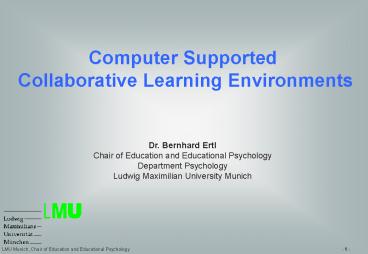Computer Supported Collaborative Learning Environments - PowerPoint PPT Presentation
1 / 40
Title:
Computer Supported Collaborative Learning Environments
Description:
Chat. Newsgroups, discussion boards, forums. Videoconferencing. Support the instructional design ... Synchronous communication scenario (chat) - 15 ... – PowerPoint PPT presentation
Number of Views:161
Avg rating:3.0/5.0
Title: Computer Supported Collaborative Learning Environments
1
Computer Supported Collaborative Learning
Environments
Dr. Bernhard Ertl Chair of Education and
Educational Psychology Department
Psychology Ludwig Maximilian University Munich
2
What does it mean?
3
Collaborative Learning
- Small groups of learners
- Working on collaboratively
- Knowledge construction
4
Learning Environment
- Learning scenario
- Learning task
- Communication scenario
- Instructional design
- Computer support
5
Computer Support
- Enable communication
- Chat
- Newsgroups, discussion boards, forums
- Videoconferencing
- Support the instructional design
- Provide resources
- Offer shared spaces
- Introduce facilitation methods
6
Learning Platform
- Technical tool for implementation e.g.
Blackboard, WebCT - Offering e.g.
- Course authoring
- User administration
- Communication
- Assessment features
7
Goals for CSCLE
- Offering benefits from new technologies
- Improving learning processes and outcomes
- Enabling distance learning
8
Central Feature of CSCLE The Shared Screen
- Entrance to the learning environment
- Provides learning context (e.g. resources)
- Providing space for knowledge construction
9
Learning Tasks and Their Realizations in CSCLE
10
Exemplary Tasks
- Group discussion
- Decision making
- Problem-solving
11
Task Group Discussion
- Analyzing a learning case
- Focus on individual analyses and group
reflections - Asynchronous communication scenario (forum)
12
Overview of the contributions in the forum
Writing a contribution
Task information and timer
Case information
Orientation map of the learning environment
Prompts in the discussion area
Weinberger (2003)
13
Characteristics
- Asynchronous discussion provides time for
elaborate analyses - Learners depend on the others contribution for
discussion - Need for similar paces
14
Task Decision Making
- Highly interactive
- Focus on collaborative negotiation
- Synchronous communication scenario (chat)
15
Elements of the learning environment (Pata, 2005)
16
Characteristics
- Synchronous communication features immersive
argumentation - Optional facilities (e.g. shared web browsing,
shared whiteboard) necessary for making important
contents permanent
17
Task Collaborative Teaching
- Interactive
- Need for elaborations
- Videoconferencing scenario
18
Videoconference
- Shared Audio
- Shared Video
- Shared Application
19
Shared Application (Text Editor)
- Interaction of genotype and environment
- Genotype (unique combination of
individuals genes) - Phenotype (individuals visible attributes
and characteristics) - Environment (all outside effects)
- Interactive structure strong interdependency
between the genotype of the parents/child, the
phenotype and the environment - 3 genotype environment effects
- Passive genotype environment effect
(parents impact in early childhood, decreases
with childs growth) - Reactive genotype environment effect
(environment reacts on the childs genotype
impact remains stable at each age) - Active genotype environment effect (when
growing up, the child takes a more and more
active role, impact of the genotype increases
niche-picking) - Evidence from twin and adoption studies
20
Characteristics
- Spoken discussion enables interaction and
elaboration - Shared application makes important contents
permanent
21
Task Collaborative Problem-Solving
- Interactive
- Focus on collaborative analyses and solutions
- Use of visualization tools
- Co-present scenario
22
Shared Visualization
23
Characteristics
- Co-present scenario enables extensive gesture of
the learners - They can use their fingers pointing on the screen
to show objects to one another.
24
Comparison
- Each communication scenario has advantages and
disadvantages - Each scenario can feature aspects or a particular
focus of the task - The issue, which kind of communication scenario
to use depends on the task
25
Conclusion
- It depends rather on the task and on the
instructional design than on the medium
26
ApplicationE-Tutors VHB a virtual course for
tutor training
- Prof. Dr. Heinz Mandl
- Katharina Schnurer, M.A.
27
Starting Point
- The Adult Education Center of Bavaria (VHB)
coordinates a large number of virtual course
offerings for Bavarian universities - To date there has been no centralized training
for the individuals who organize these offerings
28
Goal of the Course Offering
- Relaying basic knowledge about
- Tasks and roles of an E-Tutor
- Basic principles of media didactics
- Supporting virtual learners
- Technical aspects
6 week total duration with about 5 hours of
working time per week
29
Participants
- 28 individuals...
- ... from 12 different Bavaian universities
- ... from various subject areas (medicine, law,
business, education, linguistics, computer
science...)
30
Course Structure
31
Course Design
- 6 small groups of 4-5 individuals
- 1 week to complete each unit
- Within each unit, one topic to be learned through
an individual task and one group activity
32
Platform
- Open Source-Platform ComVironment
- Authoring tool
- Administration tool
- Evaluation tool
- Communication tool (asynchronous)
33
Platform Contents
34
Plattform - Communication
35
Applicability in the Course
- Group activities
- ... With self-reflection
- ... With exchange of experiences
- ... With concrete instruments
- Problem-oriented structure
- Intensive discussions in the workshops
36
Supervising the Course
- 24 hour response
- Feedback following each task
- Question exchange
- pdf-files
- Group-dynamic Observation
37
Course Evaluation
- Throughout the course after each module
(formative) - Retrospectively after the course (summative)
- Using surveys with closed-ended items and
open-ended questions
38
Course Evaluation
- Results of the summative evaluation
39
Conclusion
- Overall high acceptance of the course
- Minor problems involving the collective group
activities - Participants expressed quite heterogeneous
preferences
40
Conclusion
- A meaningful course can be achieved even using
simple and cost-effective means - Course supervision is a critical and often
underestimated factor































